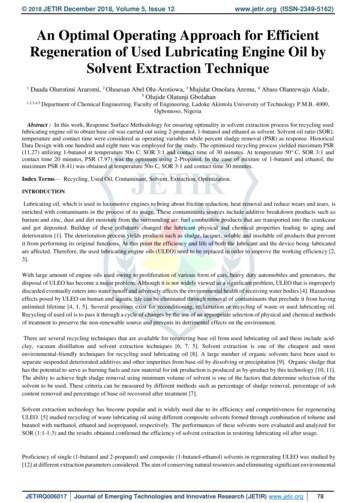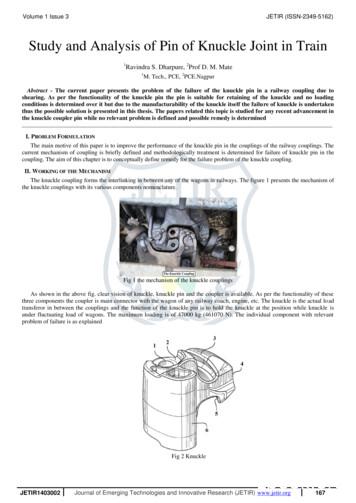2020 JETIR February 2020 , Volume 7, Issue 2 Jetir .
2020 JETIR February 2020 , Volume 7, Issue 2www.jetir.org (ISSN-2349-5162)TRIANGULAR MIRCOSTRIP PATCHANTENNA FOR 2100 MHZS. M. Palhade* & S. G. Shendesmpalhade65@gmail.comDepartment of PhysicsShri Shivaji College of Arts, Comerce & ScienceAkola 444001 (India)Abstract: Triangular microstrip patch antenna has advantage of smaller size compared to rectangular microstrip patch antennafor the chosen resonanant frequency. Its mode structure is richer than the rectangular geometry. This paper describes the designand simulation of a triangular microstrip patch antenna on RO3003 substrate for 2100 MHz using openEMS electromagnetic fieldsolver. openEMS is a free and open source electromagnetic field solver and simulator available on Linux and Windowsplatforms. It is based on the EC-FDTD algorithm which extends the Yee's FDTD algorithm. This paper first describes the ECFDTD algorithm and the openEMS electromagnetic field solver. Finally, TLM and cavity model based design and openEMSsimulation of a triangular microstrip patch antenna on RO3003 substrate for 2100 MHz is detailed. The results for the resonanantfrequency, bandwidth and directivity of the designed antenna are provided.Keywords: Electromagnetics, Computational Electromagnetics, FDTD, EC-FDTD, MOM, TLM , Microstrip Patch AntennaI. INTRODUCTIONAntenna plays prime role in the wireless technology. Modern wireless devices demand low profileand conformal antennas. Microstrip patch antenna (MPA) composed of metallic patch on a groundedsubstrate can fulfil the requirements of modern handheld and portable wireless devices [1].The microstrip patch antennas are planner electromagnetic radiating structures. They are halfwavelength long, have a high Q and low bandwidth [2]. A microstrip patch antenna on thick substrate of lowdielectric constant provides good operating bandwidth and radiation efficiency [3]. The resonant frequencyof microstrip patch antenna is determined by the geometrical shape and dimensions of the patch and ground.There are approximate models for the prediction of its resonant frequency and bandwidth. The two modelsused to create a starting design of microstrip patch antenna are the transmission line model (TLM) and thecavity model [4], [5]. These models consider that the antenna structure has infinite or very large groundplane which in practice is small for the modern wireless handheld and portable devices. The initial design,therefore, needs testing and refinements before actual antenna is fabricated. The testing of and refinement tothe initial design is done using computer simulation and its geometrical parameters are adjusted to get thedesired resonant frequency and bandwidth.The microstrip patch antenna can be modelled and simulated using commercial and licensedsimulators like HFSS, XFdtd, EMCoS, FEKO, CST MWS etc [6]. These simulators are electromagneticsolvers that employ one of the numerical methods from the finite element method (FEM), Yee’s finitedifference time domain (FDTD) algorithm, and the method of moments (MOM) [7], [8]. These softwareshave graphical user interface (GUI) and good technical support. On the other hand, free electromagneticfield solvers like MEEP, gprMax, Angora, emGine, openEMS available on the internet are mostly text based,without any dedicated support and demand self learning [9].openEMS is EC-FDTD (equivalent circuit FDTD) based free and open source electromagnetic fieldsolver developed by Thorsten Liebig et al [10]. It is available for both Linux and Windows platforms. In thiswork, the EC-FDTD algorithm is first desribed briefly and then the design of a triangular microstrip patchantenna for 2100MHz on RO3003 substrate is outlined. Finally, the antenna simulation using openEMS toarrive at a final antenna design suitable for actual fabrication is detailed.EC-FDTD and openEMSMany complex electromagnetic field problems have been solved using the Yee finite-difference timedomain (FDTD) algorithm [10]. The Yee algorithm translates the electromagnetic equations into a directand explicit numerical method to solve electromagnetic problems. It considers both the electric andmagnetic field components. The equivalent circuit (EC-FDTD) approach, on the other hand, considersJETIRDI06124Journal of Emerging Technologies and Innovative Research (JETIR) www.jetir.org635
2020 JETIR February 2020 , Volume 7, Issue 2www.jetir.org (ISSN-2349-5162)circuit variables like voltages and currents instead of fields. The EC-FDTD scheme is derived fromMaxwell’s equations in integral form by discretizing them using the Yee algorithm [11]. The EC-FDTDscheme can be summarized using two update equations(1)(2)where,and,,andwhere,andare the edges of the Yee computational cell.The EC FDTD algorithm iteratively updates both sets of equations (1) and (2) until there is a completedissipation of energy from the simulation domain.openEMS is a free and open source electromagnetic field solver based on the EC-FDTD algorithm.It supports 3D cartesian as well as cylindrical coordinates. It uses CSXCAD C library to describegeometrical objects and their physical or non-physical properties [12]. It provides MUR and PML absorbingboundary conditions (ABCs). MATLABTM and GNU Octave interface is provided for easy scripting. Theelectromagnetic problem to be solved is described in a MATLAB/Octave script file which includes thegeometry and physical properties of computational domain, meshing of the computational domain, theexcitation and port, calculations and post processing instructions.Antenna DesignThe initial design of triangular microstrip patch antenna for 2100 MHz on RO3003 substrate with dielectricconstant 3.0 and thickness 1.524 mm using the transmission line model (TLM) and the cavity model isdescribed here. The design steps are detailed in the Table 1 below [13].Table 1 Design StepsParameterFormulaValue1 Free Space Wavelength142.86 mm2 Triangle Side Initial54.96 mm3 Effective Dielectric Constant4 Effective Patch Length2.9955.83 mm5 Design Equation6 Triangle Side Final55 mmThe initial design using the parameter values from the Table 1 was simulated using openEMS withGNU Octave script which gave 1727 MHz resonant frequency with -20 dB reflection coefficient and 63 Ωinput resistance. Therefore, the triangular patch side length a was reduced from the initial 55 mm in steps of1mm to obtain the resonant frequency of 2065 MHz at a 50 mm. In the next step, the feed position wasvaried from the initial value 0.0 in steps of 1 mm to obtain a reflection coefficient -35 dB and inputresistance 50.2 Ω at feed position -12.00 mm from the center of the patch. The openEMS simulation predictsmax directivity of Dmax 4.7951 (6.808 dBi) and radiation efficiency 89.94 % for the final antennadesign. The final design is summarized in the Table 2.JETIRDI06124Journal of Emerging Technologies and Innovative Research (JETIR) www.jetir.org636
2020 JETIR February 2020 , Volume 7, Issue 2www.jetir.org (ISSN-2349-5162)Table 2 Final Design Summary1Substrate Dielectric Constant3.02Substrate Thickness1.524 mm3Triangle Side50 mm4Resonant Frequency (TM10 )2065 MHz5Feed Position(-12.00 mm, 0.00 mm)6Ground70 mm X 70 mm7Dmax and Efficiency4.7951 (6.808 dBi) & 89.94 %Results and DiscussionThe openEMS simulation results for reflection coefficient S11, input impedance Zin and radiationpattern of the microstrip patch antenna are presented here. The S11 graph clearly shows that the antenna isresonant at 2065 MHz and the minimum value of the reflection coefficient is -35 dB. The -10 dB bandwidthis about 20 MHz only as the antenna is a simple equiilateral triangular patch on the substrate of dielectricconstant 3 with thickness 1.524 mm.Figure 1. S11 versus FrequencyThe Smith chart clearly shows that the antenna input impedance is purely resistive at 2065 MHz. Thecomplete single loop on the chart indicates that the antenna design has only one resonant frequency in thefrequency range from 1 GHz to 3 Ghz.Figure 2. Smith ChartJETIRDI06124Journal of Emerging Technologies and Innovative Research (JETIR) www.jetir.org637
2020 JETIR February 2020 , Volume 7, Issue 2www.jetir.org (ISSN-2349-5162)The input impedance graph indicates that at 2065 MHz, the antenna input impedance is purely resistive, thereactive part being zero. The antenna input impedance is 50.2 Ω.Figure 3. Input Impedance ZinThe radiation pattern is broadside and back lobe of radiation is very small in both the E and H planes. Thesimulation predicts that the directivity will have a maximum value of DMAX 4.7951 (6.808 dBi ) andradiation efficiency will be 89.94 %Figure 4. Radiation Pattern ( polar )Figure 5. Radiation Pattern ( cartesian )ConclusionA probe fed type simple equiilateral triangular patch microstrip patch antenna for the frequency 2100 MHzon RO3003 substrate has been successfully simulated using a free and open source EC-FDTD basedelectromagnetic field solver openEMS. The patch is equiilateral triangular with side length 50 mm and thesubstrate dimensions are 70mm X 70mm. The simulation results predict a resonant frequency of 2065 MHzwith reflection coefficient of -35 dB and -10 dB bandwidth of 20 MHz. The radiation pattern simulationpredicts a maximum directivity of 4.7951 (6.808 dBi ) and radiation efficiency of 89.94 %. This workemploys free and open source softwares like openEMS, GNU Octave and Linux operating system.JETIRDI06124Journal of Emerging Technologies and Innovative Research (JETIR) www.jetir.org638
2020 JETIR February 2020 , Volume 7, Issue 2www.jetir.org [9][10][11][12][13]C. A. Balanis, Antenna Theory : Analysis and Design, 3rd ed., Wiley India, 2009R. Bancroft, Microstrip and Printed Antenna Design, 1st ed., Prentice Hall of India, 2006E. Chang, S. Long, and W. Richards, “An Experimental Investigation of Electrically Thick Rectangular Microstrip Antennas,”IEEE Transactions on Antennas and Propagation,, vol. 34, no. 6, pp. 767–772, 1986.H. Pues and A. Van de Capelle, “Accurate transmission-line model for the rectangular microstrip antenna,” in IEEProceedings H (Microwaves, Optics and Antennas), vol. 131, pp. 334–340, 1984.W. Richards, Y. Lo, and D. Harrison. “An Improved Theory for Microstrip Antennas and Applications,” IEEE Transactions onAntennas and Propagation, 29(1):38–46, 1981.[Online]. Available: https://en.wikipedia.org/wiki/Comparison of EM simulation softwareRoger F. Harrington. Field Computation by Moment Methods. Wiley, 1993K. S. Yee, “Numerical Solution of Initial Boundary Value Problems Involving Maxwell’s Equations in Isotropic Media,”IEEE Transactions on Antennas and Propagation, 14(3):302–307, 1966.[Online]. Available: http://emlab.utep.edu/opensource.htmT. Liebig, A. Rennings, S. Held and D. Erni, “openEMS – a free and open source equivalent-circuit (EC) FDTD simulationplatform supporting cylindrical coordinates suitable for the analysis of traveling wave MRI applications,” Int. J. Numer.Model., 26: 680-696, 2012Allen Taflove. Advances in Computational Electrodynamics: The Finite-Difference Time-Domain Method. Artech House,1998.openEMS [Online]. Available: http://openems.de/Girish Kumar and K. P. Ray. Broadband Microstrip Antennas. Artech House, 2003.JETIRDI06124Journal of Emerging Technologies and Innovative Research (JETIR) www.jetir.org639
Many complex electromagnetic field problems have been solved using the Yee finite-difference time-domain (FDTD) algorithm [10]. The Yee algorithm translates the electromagnetic equations into a direct and explicit numerical method to solve electromagnetic problems. It considers both the electric and magnetic field components.
2018 JETIR September 2018, Volume 5, Issue 9 www.jetir.org (ISSN-2349-5162) JETIR1809072 Journal of Emerging Technologies and Innovative Research (JETIR) www.jetir.org 349 INTEGRATING PREDICTIVE ANALYTICS AND SOCIAL MEDIA 1 S.Leema Mary, 2 S.Benita Deepthi, 1Head and Associate Professor, 2ME Computer Science
2018 JETIR December 2018, Volume 5, Issue 12 www.jetir.org (ISSN-2349-5162) JETIRQ006017 Journal of Emerging Technologies and Innovative Research (JETIR) www.jetir.org 79 impact through regenerating ULEO was achievable with 1-butanol displaying the best performance.
July 2016, Volume 3, Issue 7 JETIR (ISSN-2349-5162) JETIR1607013 Journal of Emerging Technologies and Innovative Research (JETIR) www.jetir.org 59 Note that in a counter-flow heat exchanger the outlet temperature of the cold flu
January 2018, Volume 5, Issue 1 JETIR (ISSN-2349-5162) JETIR1801167 Journal of Emerging Technologies and Innovative Research (JETIR) www.jetir.org 837 democratic thought of the modern West" and the b
2018 JETIR August 2018, Volume 5, Issue 8 www.jetir.org (ISSN-2349-5162) JETIRD006040 Journal of Emerging Technologies and Innovative Research (JETIR) www.jetir.org 284 Figure 2 Conv
2018 JETIR April 2018, Volume 5, Issue 4 www.jetir.org (ISSN-2349-5162) JETIR1804180 Journal of Emerging Technologies and Innovative Research (JETIR) www.jetir.org 881 Flue
Volume 1 Issue 5 JETIR (ISSN-2349-5162) JETIR1405007 Journal of Emerging Technologies and Innovative Research (JETIR) www.jetir.org 283 A Case Study on Total Productive Maintenance in Rolling Mill Chetan S Sethia1, Prof. P. N. Shende2, Swapnil S Dange3 1Student, M.TECH (PRODUCTION), 2Assistant professor, 3Student, M.TECH (PRODUCTION)
Volume 1 Issue 3 JETIR (ISSN-2349-5162) JETIR1403002 Journal of Emerging Technologies and Innovative Research (JETIR) www.jetir.org 167 Study and Analysis of Pin of Knuckle Joint in Train 1Ravindra S. Dharpure, 2Prof D. M. Mate 1M. Tech., PCE, 2PCE.Nagpur Abstract - The current paper presents the problem of the failure of the knuckle pin in a railway coupling due to























